Kočani
Kočani (Macedonian: Кочани [ˈkɔtʃani] (![]() listen)) is a town in the eastern part of North Macedonia, situated around 100 kilometres (62 mi) east from Skopje. It has a population of 28,330 and is the seat of the Kočani Municipality.[2]
listen)) is a town in the eastern part of North Macedonia, situated around 100 kilometres (62 mi) east from Skopje. It has a population of 28,330 and is the seat of the Kočani Municipality.[2]
Kočani
| |
|---|---|
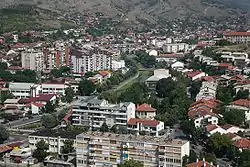 | |
 Flag 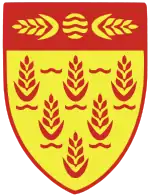 Seal | |
| Motto(s): City of rice and geothermal water | |
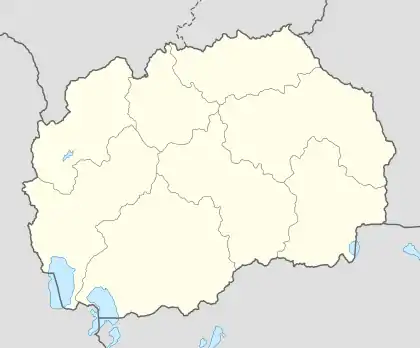 Kočani Location within North Macedonia | |
| Coordinates: 41°55′N 22°25′E | |
| Country | |
| Region | |
| Municipality | |
| Geoname | 789403 |
| Founded | 1337 [1] |
| Council | SDSM - 10, VMRO-DPMNE - 8, Independent - 1 |
| Government | |
| • Mayor | Nikolco Ilijev (SDSM) |
| Area | |
| • Total | 18.6 km2 (7.2 sq mi) |
| Highest elevation | 420 m (1,380 ft) |
| Lowest elevation | 350 m (1,150 ft) |
| Population (2002) | |
| • Total | 28,330 |
| • Density | 1,500/km2 (3,900/sq mi) |
| Time zone | UTC+1 (CET) |
| • Summer (DST) | UTC+2 (CEST) |
| Area code(s) | (++389) 33 |
| Car plates | KO |
| Official language | Macedonian |
| Geothermal water temperature | 78°C |
| Settlements | 28 |
| Climate | Cfa |
| Website | www.kocani.gov.mk |
Geography and population
The town spreads across the Northern side of the Kočani valley, along the banks of the Kočani river, where it leaves the mountain slopes and flows through the valley. North of the town there is the Osogovo mountain (2,252 m or 7,388 ft) and 8 kilometres (5.0 mi) to the south the valley is closed by the mountain Plačkovica (1,754 m or 5,755 ft). The town is 350–450 m (1,150–1,480 ft) above sea level.
Kočani spreads over an area of 18.6 square kilometres (7.2 sq mi) and has population of 28,330 inhabitants which makes it the third regional center in the Eastern part of the country:
- 1948 - 6,657 inhabitants
- 1994 - 26,364 inhabitants
- 2002 - 28,330 inhabitants
Ethnic structure
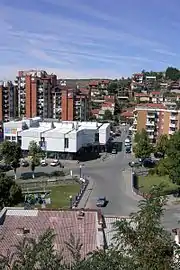
- Macedonian: 90.3%
- Roma: 5.0%
- Turks: 3.0%
- Vlachs: 0.5%
- Serbs: 0.2%
- Other: 1.0%
Climate
The climate is humid subtropical (Köppen: Cfa), influenced by altered Mediterranean climate which penetrates along the river Bregalnica. The average temperature is 12.9 °C (55.2 °F) with 538 mm (21.2 in) rainfall.
History
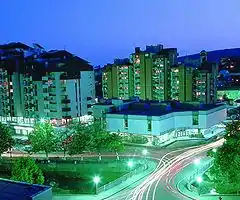

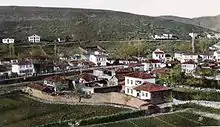
Due to its favourable geographic location, together with excellent natural climate characteristics, Kočani was inhabited as early as the ancient times first by the Paionians, Meds and Thracians. Later on, in the 6th century the Slavs inhabited parts of the region. More precisely, in the 7th century members of the Slavic tribe Smolyani colonized the Kočani valley and built a fortification. The founders of the Slavic education, brothers Kiril and Metodij (Cyril and Methodius), stayed in the valley from the year 845 to 855 and in the Bregalnica area (Morodvis) started to preach Christianity in Slavic language.
Although the settlement existed long before that, Kočani was first mentioned in a charter from 1337 in which Despot Jovan Oliver donated the church of St. Dimitrija to Kočani.
Archaeological finds in the town itself have revealed remains of a settlement here in the Roman and Byzantine periods. Early in the 15th century it fell under Turkish rule. The travel chronicler Evliya Chelebi, who visited it in 1662, recorded that it had 600 households, a mosque, a mezjid, an inn and 15 handicraft stores. During the 18th and in the early 19th century, the town growth rate stagnated. It was only around 1878 that the population began to rise, at which time it had about 450 - 500 households. The town has two feudal residences in the shape of towers believed to date from the 16th - 17th century.
Monuments
Numerous cultural and historical monuments, from ancient times to the Middle Ages, can be found in the vicinity of Kočani. One of them is an archeological site of Dolno Gradishte from the late antic period, and two medieval towers at the city center.
Monastery complexes in the nearby villages Morodvis and Panteley are world-famous both for their architecture and unique frescoes.
Features
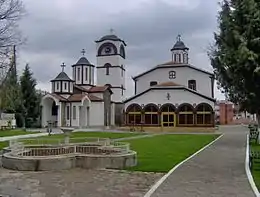
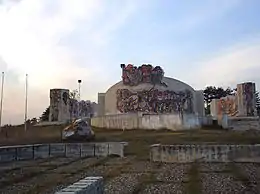
The town green, especially along the river bed and banks of the Kočani river, is the pride of the local people. The town is very clean and neat, for which it has proudly held the prestigious title of the cleanest town in North Macedonia.[3]
Today Kočani is a modern town with planned infrastructure, avenues, many modern buildings and blocks of flats, a hospital, a shopping centre, a park and a newly built industrial zone. All this is carefully planned and structured, according to modern standards of living and esthetics. New suburbs are mainly built to the east where the town almost reaches the first houses of Orizari and to the West spreading over the industrial zone.
Education
The City of Kočani is served by four primary schools:
- Nikola Karev Primary School
- Saints Cyril and Methodius Primary School
- Rade Kratovče Primary School
- Malina Popivanova Primary School
There are also two secondary schools:
- Ljupčo Santov Gymnasium (specializing in economics)
- Gjošo Vikentev (specializing in electronics and machining)
There is also a primary school specializing in music:
- Risto Jurukov Primary School for Music
The city also maintains a municipal library "Iskra" ("spark").
Sports
Local football club FK Osogovo has played several seasons in the Macedonian First Football League.
Town partnerships
Kočani maintains partnership links with the following places:
Notable people
- Kočani Orkestar, musicians
- Kiril F. Dzmbov, nuclear physicist, member of the Serbian Academy of Sciences and Arts and of MANU
- Rade Kratovče, revolutionary
- Pavle Krošarev, pilot, (the first Macedonian civil-aviation pilot to achieve the rank of an airline captain)
- Branko Pendovski, writer, president of the Writers' Association of Macedonia
- Malina Popivanova, revolutionary
- Blagoja Popov, politician, Chairman of the Executive Council (Prime Minister) of Macedonia 1974-1982
- Blagoj S. Popov, mathematician and first Dean of the Faculty of Natural Sciences and Mathematics of the University of Skopje, member of MANU
- Ljupčo Santov, revolutionary
- Stevo Teodosievski, musician
- Boyka Vaptsarova bg, public figure, wife of Bulgarian poet Nikola Vaptsarov
- Jordan Pop-Jordanov, engineer and physicist, member of the Macedonian Academy of Sciences and Arts
- Dr. Blagica Jovanova,engineer and Ph.D in computer science, scientist, visiting Professor in Universities in Paris and Macedonia, member and contributor of MPEG standards
- Simeon Kango Ivanov, musician
- Gošo Vikentiev, commander in the XIV Macedonian Youth National Liberation Brigade in the attack to liberate Kočani from the Axis powers during World War II
See also
References
- ""Kočani" (history)" (in Macedonian).
- "North Macedonia Timeless". northmacedonia-timeless.com. Retrieved 2020-04-21.
- "Куманово е втор град во државата по зелени површини". KumanovoNews. Retrieved 2020-04-21.
External links
| Wikimedia Commons has media related to Kočani. |
